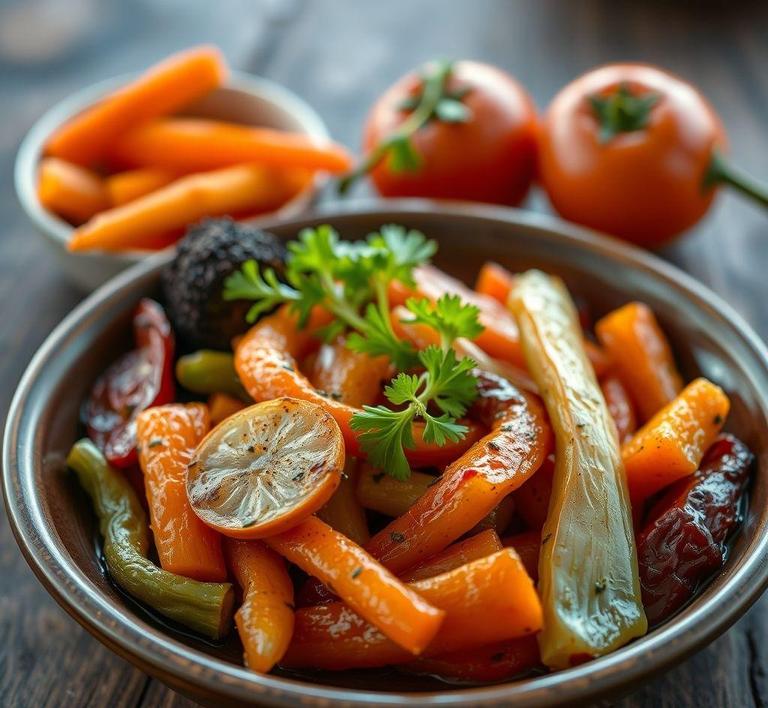Refreezing cooked vegetables can be a bit of a tricky topic, but with the right knowledge and a little care, it’s definitely doable! Whether you’ve made a big batch of stew or just have some leftover roasted veggies, knowing how to safely refreeze them can help reduce food waste and save time for future meals. However, it’s important to consider factors like texture changes, the impact on flavor, and food safety. In this guide, we’ll walk you through everything you need to know about how to properly refreeze cooked vegetables, ensuring that they stay safe and tasty for your next meal!
Can You Refreeze Cooked Vegetables?

The question of whether or not you can refreeze cooked vegetables is one that many home cooks, meal planners, and food enthusiasts often ask. While the idea of refreezing food may seem like a convenient way to prevent waste or preserve leftovers, it’s important to understand the impact on food safety, texture, and taste.
Technically, you can refreeze cooked vegetables, but it’s not always advisable, depending on how they were handled during their first freezing and thawing process. The real concern lies in the potential risks of bacterial growth and the degradation of the vegetable’s texture and nutritional value. Freezing and thawing vegetables multiple times can cause them to lose moisture, which may lead to sogginess and a mushy texture when reheated. Additionally, each freeze-thaw cycle slightly diminishes the nutritional content of the food, particularly the vitamins that are sensitive to heat and freezing.
From a food safety perspective, it’s crucial to consider how quickly the vegetables were thawed and how long they sat at room temperature after thawing. If they were kept at room temperature for an extended period (longer than two hours), it’s best to avoid refreezing, as bacteria can begin to grow rapidly at temperatures between 40°F and 140°F (4°C – 60°C), which may increase the risk of foodborne illness. However, if cooked vegetables were thawed in the refrigerator and never left out too long, the risks of refreezing are minimized, though still present.
How To Refreeze Cooked Vegetables?
If you do decide to refreeze cooked vegetables, following proper methods to ensure their safety and quality is key. Here’s how to do it the right way:
- Cool Quickly: After cooking vegetables, allow them to cool down as quickly as possible before freezing. The faster you cool them, the less time they’ll spend in the ‘danger zone’ (above 40°F, where bacteria grow). You can do this by placing the cooked vegetables in shallow containers or spreading them out on a baking sheet to cool quickly before transferring them to the freezer.
- Thaw Properly: When it comes time to thaw, avoid leaving vegetables at room temperature for too long. Thaw them in the refrigerator if you plan on refreezing them. Thawing in the fridge keeps the vegetables at a safe temperature and slows the growth of any bacteria that might have developed.
- Use Airtight Containers: When packing your cooked vegetables for the freezer, make sure to use airtight containers or heavy-duty freezer bags. This helps to preserve the quality by preventing freezer burn, which occurs when air is trapped inside the packaging and the food dries out. For optimal freshness, you can also remove as much air as possible from the freezer bag.
- Label and Date: Always label the containers with the contents and the date they were frozen. This ensures you can keep track of how long the vegetables have been in the freezer, and you’ll know whether it’s still safe to eat or if they’re past their prime.
- Freeze in Portions: It’s a good idea to freeze cooked vegetables in smaller portions. This way, you only need to thaw what you plan to use, rather than having to refreeze the entire batch again.
- Use Within a Reasonable Time: Cooked vegetables can generally be stored in the freezer for 2-3 months before quality begins to degrade. The longer they stay frozen, the more the texture and flavor will be affected.
Quality Impact
While refreezing cooked vegetables is technically possible, the process does have a significant impact on their quality. Here’s a breakdown of what to expect:
- Texture Changes: One of the most noticeable effects of refreezing cooked vegetables is a change in texture. When vegetables are initially frozen, ice crystals form within their cellular structure. Thawing and refreezing causes these ice crystals to break down the cell walls even further. As a result, when refrozen vegetables are reheated, they often become mushy and lose their crispness. This is particularly true for vegetables with high water content, such as spinach, tomatoes, and cucumbers.
- Flavor Degradation: Freezing vegetables can impact their flavor, and multiple freeze-thaw cycles can exacerbate this issue. Some vegetables may lose their fresh, vibrant taste and take on a more bland or ‘off’ flavor after being refrozen. This can be more noticeable with delicate vegetables like peas, green beans, and corn. Additionally, some vegetables may have a more pronounced “freezer” taste or odor if they were not stored properly in airtight packaging.
- Nutritional Loss: Freezing cooked vegetables can cause a reduction in certain nutrients, especially those that are sensitive to temperature, like vitamin C and certain B vitamins. Each freeze-thaw cycle can further deplete these nutrients. While freezing does preserve a significant amount of nutrients compared to other preservation methods like canning, refreezing still contributes to the breakdown of vitamins and antioxidants.
- Risk of Freezer Burn: If the vegetables are not packed well enough, they may experience freezer burn. This occurs when the food is exposed to air in the freezer, leading to dehydration and the formation of ice crystals on the surface. While freezer-burned food is still technically safe to eat, it can affect the texture and flavor, making it unappetizing.
While the answer to "Can you refreeze cooked vegetables?" is technically yes, the better question might be: Should you? Refreezing cooked vegetables does come with trade-offs, especially when it comes to texture, flavor, and nutritional content. The process can cause vegetables to become mushy, bland, and less nutritious. However, if you handle the vegetables with care-cooling them rapidly, thawing them properly, and freezing them in airtight containers-it is possible to refreeze them with minimal quality loss.
In general, it’s best to avoid multiple freeze-thaw cycles, as they compromise the food’s safety and eating experience. If you do plan to refreeze cooked vegetables, aim to consume them within a few months for the best quality, and always consider how much texture and flavor matter to you before proceeding.
Ultimately, while refreezing may save food from going to waste, it’s important to be mindful of the potential drawbacks. If possible, try to plan your cooking and freezing strategies to minimize the need for refreezing, preserving the original quality of your vegetables.
Is It Safe To Refreeze Cooked Vegetables?
Refreezing cooked vegetables is a topic that raises questions about food safety, quality, and the longevity of stored foods. While the idea of refreezing might seem convenient, especially when you’ve got leftovers or accidentally thawed too much, there are several factors to consider.
In principle, cooked vegetables can be refrozen, but only if they’ve been handled properly during the thawing process. If cooked vegetables were thawed safely in the fridge and have not been left out at room temperature for more than two hours, they are less likely to harbor harmful bacteria. That being said, freezing and thawing multiple times can significantly affect the taste, texture, and nutritional value of the vegetables. So, while refreezing may be safe under certain circumstances, it is not always the best option when it comes to maintaining the quality of the food.
From a microbiological perspective, the key issue is the risk of bacterial growth. Freezing slows down bacterial activity but does not kill it. When food is thawed, bacteria can begin to multiply, particularly if it’s left at room temperature for too long. If cooked vegetables were initially frozen and thawed properly but were not exposed to unsafe temperatures during thawing, refreezing them should theoretically be safe. However, if they’ve been left out too long or thawed improperly (like in warm water or on the countertop), the risks of contamination increase. It’s essential to err on the side of caution when it comes to food safety.
Signs That Cooked Vegetables Should Not Be Refrozen
While refreezing cooked vegetables can be done safely under certain circumstances, there are clear signs that indicate when they should not be refrozen. Understanding these signs is vital for both food safety and ensuring that you are not compromising the taste or nutritional value of your meal.
- Off Smell or Sourness: If the cooked vegetables have developed an unpleasant odor or sour smell, this is a clear indication that they have started to spoil. The presence of an off smell signals bacterial growth, and consuming them could lead to foodborne illness. These vegetables should not be refrozen under any circumstance.
- Slimy or Mushy Texture: Freezing and thawing cause vegetables to lose water, and certain vegetables like leafy greens, tomatoes, or zucchini may become mushy or slimy once thawed. If the texture of your vegetables has significantly changed to the point of being overly mushy or slimy, they will likely not fare well after being refrozen. Refreezing them will only exacerbate the texture issues and could lead to an unpleasant eating experience.
- Presence of Ice Crystals or Frost: If your cooked vegetables are covered in ice crystals or have frost on them after thawing, it could indicate that they were improperly frozen to begin with or have been thawed and refrozen multiple times. The more moisture trapped in these vegetables, the greater the risk of freezer burn, which leads to poor flavor, texture, and overall quality. If you notice this, it’s best to avoid refreezing.
- Temperature Fluctuations: If your vegetables were left in the “danger zone” (between 40°F and 140°F, where bacteria grow most rapidly) for more than two hours, they should not be refrozen. Even if the vegetables appear fine on the surface, they may harbor bacteria that can multiply once thawed again, posing a health risk.
- Visible Signs of Freezer Burn: Freezer burn appears as discolored patches, usually light gray or brown, and occurs when food is exposed to air inside the freezer. This is a sign that moisture from the vegetables has evaporated, leaving behind dry, shriveled portions that will likely not improve with refreezing. Freezer-burned vegetables may still be safe to eat but will have a significantly diminished flavor and texture.
Common Refreezing Mistakes
Refreezing cooked vegetables is not an exact science, and several common mistakes can compromise both food safety and the overall quality of the dish. Avoiding these errors will help ensure that your meals remain safe, delicious, and nutritious.
- Refreezing After Thawing at Room Temperature: The biggest mistake you can make when refreezing cooked vegetables is thawing them at room temperature for extended periods of time. Bacteria thrive in temperatures between 40°F and 140°F, so if your cooked vegetables have been out for more than two hours, the risks of contamination increase dramatically. Always defrost in the fridge, microwave, or using cold water if you intend to refreeze.
- Not Cooling Properly Before Freezing: It’s crucial to cool cooked vegetables properly before freezing them initially. If you freeze vegetables while they are still hot, it can raise the temperature inside the freezer, potentially compromising the safety of other foods. Rapidly cooling vegetables by placing them in shallow containers or using an ice bath before freezing is essential for safe storage.
- Refreezing in Large Quantities: While it may be tempting to refreeze large portions, doing so can lead to uneven freezing and thawing. This inconsistency can create pockets of food that are improperly frozen, making them more susceptible to freezer burn or bacterial growth. Portioning vegetables into smaller, manageable sizes will help them freeze evenly and thaw quickly when needed.
- Ignoring Storage Time: Each time food is frozen and thawed, its quality deteriorates. Refreezing vegetables should be done with the awareness that the more times they are frozen and thawed, the more their texture, flavor, and nutrient content will suffer. Keeping track of how long food has been in the freezer and limiting refreezing to a minimum will help preserve quality.
- Freezing with Excess Water: Vegetables often release moisture when frozen. If you don’t drain them properly before freezing or refreezing, excess water can form ice crystals inside the package, leading to freezer burn and texture changes. It’s best to blanch vegetables before freezing them, as this helps lock in moisture and preserves their texture and color.
Tips And Tricks
While refreezing cooked vegetables is possible, there are several tips and tricks that can make the process more efficient and safer, ensuring that your food remains both safe and of good quality.
- Use Proper Containers: Always use airtight, moisture-proof containers or heavy-duty freezer bags to prevent freezer burn and protect the flavor and texture of the vegetables. For added protection, consider vacuum-sealing the vegetables before freezing or refreezing.
- Cool Vegetables Quickly: If you have leftovers or need to store cooked vegetables for later use, cool them down as quickly as possible. Use shallow containers, divide large batches into smaller portions, or place the containers in an ice bath to speed up the cooling process.
- Blanch Vegetables Before Freezing: Blanching vegetables before freezing them is an excellent way to preserve their color, texture, and nutritional value. It involves briefly boiling the vegetables and then rapidly cooling them in ice water before freezing. This process can make a big difference when you are considering refreezing.
- Label and Date: To avoid losing track of how long cooked vegetables have been in the freezer, always label and date them. This will help you keep an eye on their age and avoid refreezing anything that has been in the freezer for too long.
- Only Refreeze Once: If you must refreeze cooked vegetables, limit the process to just one cycle. Repeated freezing and thawing degrade both the texture and the nutritional content of the food, so refreezing should be a rare necessity, not a habit.
- Consider Using Refrozen Vegetables in Different Dishes: After refreezing, cooked vegetables may not have the same texture as fresh or first-time frozen vegetables. Consider using them in soups, stews, or casseroles, where the texture is less important, but the flavor still shines.
Conclusion
While it is technically safe to refreeze cooked vegetables in certain situations, the decision to do so should be made carefully. Food safety should always be your priority-proper thawing, cooling, and storage practices are essential for avoiding bacterial contamination and maintaining the quality of the vegetables. Signs of spoilage, freezer burn, or temperature abuse are all red flags indicating that refreezing is not the best option.
When done correctly, refreezing cooked vegetables can help reduce food waste and extend the shelf life of your leftovers. However, it’s important to recognize that each cycle of freezing and thawing can diminish the flavor, texture, and nutritional value of your food. With the right precautions, knowledge of safe handling techniques, and attention to detail, you can enjoy cooked vegetables safely and avoid the common pitfalls of refreezing.

